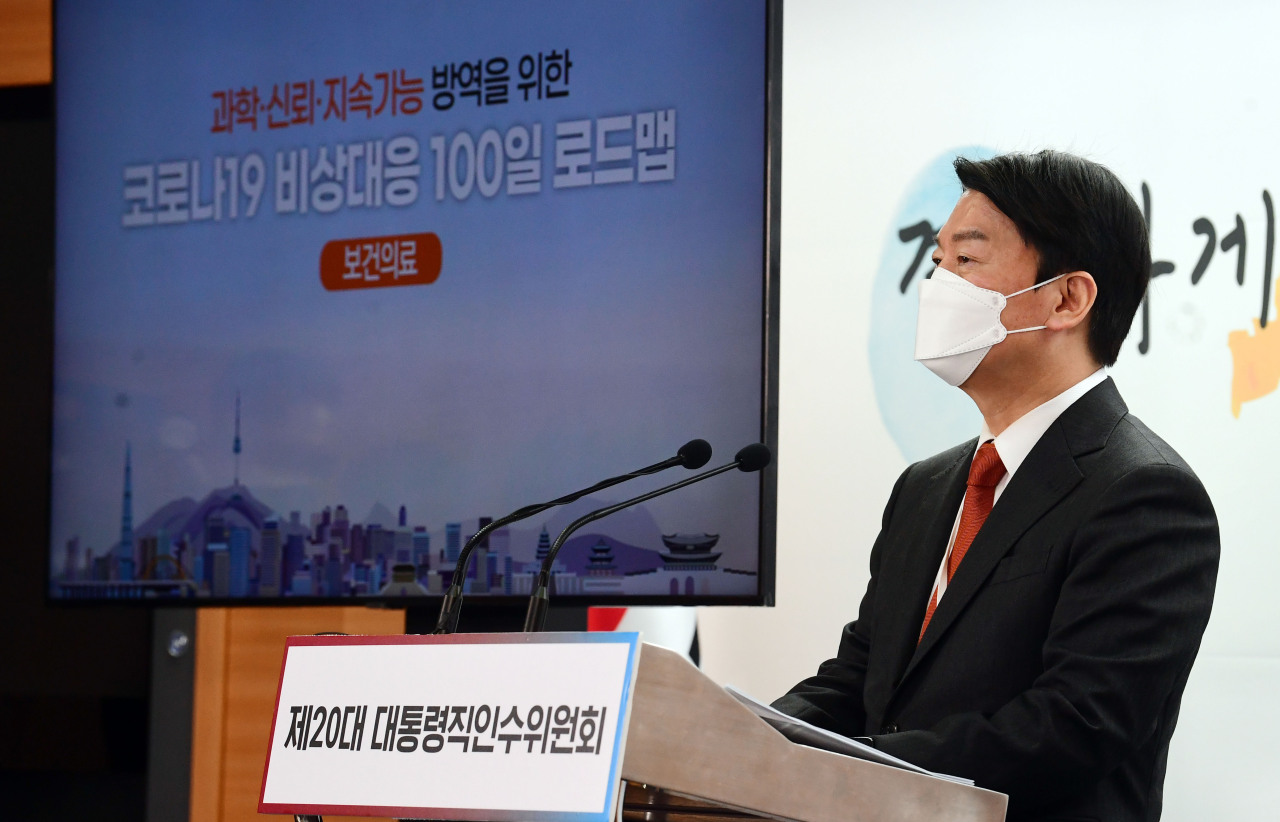
President-elect Yoon Suk-yeol comes into office as South Korea’s huge omicron wave is subsiding. Daily cases have been falling for six consecutive weeks, now down by nearly 80 percent from the peak in mid-March.
The presidential transition team’s COVID-19 task force on Wednesday unveiled a plan illustrating how the new administration would handle the recovery phase of the pandemic.
Last week incumbent President Moon Jae-in celebrated “the return of normal” before the end of his term, after scrapping social distancing completely with the exception of the face mask mandate. Health officials have ended other measures to manage the pandemic like universal free testing and contact tracing.
The COVID-19 task force of Yoon’s transition team, led by Ahn Cheol-soo, was cautious about an end to indoor and outdoor masking. But the team said it has decided to endorse the Moon administration’s call to downgrade COVID-19’s threat status so that it is no longer treated as a high-consequence disease.
The downgrade in the disease threat status means the mandatory isolation period will be removed. Under current guidance people are required to isolate for a minimum of seven days from the day of a positive test. Costs of testing and treatment will no longer be covered by the government, either.
The following is a rundown of some of the key goals to be pursued over Yoon’s first 100 days in office, before the weather cools and fall arrives.
No more curfews, closures
All restrictions on businesses were lifted with the end of social distancing on April 18. But even in the possible event of another rise in cases, the burden on small businesses to comply with restrictions like curfews and closures will be minimized, Ahn said.
Instead of limiting business hours or closing places down following outbreaks, other solutions like boosting ventilation systems will be provided to ensure businesses can stay open as much as possible.
Regular antibody testing
Antibody positivity prevalence rates will be used to guide policy decisions like the next round of universal vaccinations or the reintroduction of social distancing rules. Countrywide antibody surveillance will be conducted regularly to help reach “informed public health decisions,” Ahn said.
So far there have been six rounds of antibody prevalence surveys involving small sample sizes since August 2020.
Increasing availability of key drug, Paxlovid
More efforts will be undertaken to expand access to Paxlovid, an oral antiviral treatment from Pfizer, which has been slow to roll out in the country. As of the latest data available on April 22 since the first shipments arrived on Jan. 13, only 221,192 people have received Paxlovid out of more than 16 million people who have become infected with COVID-19 over the period.
Ahn said the current multistage process to get a Paxlovid prescription will be “fast-tracked” for high-risk groups like the elderly. The pills, which must be prescribed within a few days of the first symptoms, will be handed out on the day a test returns positive for high-risk groups, he said.
Currently there are 85,773 courses remaining in the country. In the latter half of the year, some 500,000 courses will be brought in, Ahn said, with another 500,000 anticipated to become available early next year.
Ensuring medical access for infectious patients
Ahn pointed out patients have been denied access to medical services while they are still infectious or having COVID-19-like symptoms.
He said emergency rooms and special clinics will be set up for pregnant women, children, dialysis patients and patients with other acute or emergent health needs so that they will be ensured access to medical services even after a COVID-19 diagnosis.
Long COVID-19 monitoring
Monitoring of post-COVID-19 sequelae will be carried out as a government program, which is also something that has not yet been done. This data is to be used to help health professionals and patients understand long-term trajectories of the disease and provide related care.
By Kim Arin (arin@heraldcorp.com)

















![[KH Explains] Hyundai's full hybrid edge to pay off amid slow transition to pure EVs](http://res.heraldm.com/phpwas/restmb_idxmake.php?idx=652&simg=/content/image/2024/04/18/20240418050645_0.jpg&u=20240418181020)

![[Today’s K-pop] Zico drops snippet of collaboration with Jennie](http://res.heraldm.com/phpwas/restmb_idxmake.php?idx=642&simg=/content/image/2024/04/18/20240418050702_0.jpg&u=)